A Smattering of Books for the Amateur Weather Enthusiast
- cruising
- By Ben May, Board Director of the National Weather Association Foundation
- Jun 2, 2021
I tend to go overboard for books. I value my library card more than my driver’s license. But then, I’m a book addict.
There are so many books on meteorology that it can stagger the mind. You really don’t need to read a ton of books if you are an amateur, but you should get some orientation and familiarity with terms and processes. My experience with meteorology is that I learn more when I go from broad and wide to narrow and focused. I have found this to be useful in making a forecast as well, but that is a subject for my next blog post.
History of Meteorology and Numerical Weather Prediction
I divide the books into general weather and more specific aspects of meteorology. I am very much a student of the history of meteorology: the scientific, technical ‘giants’ and personalities of the past who contributed so much to the profession. As great as computers are, people still make things happen. But unless you are a weather history buff, just breeze by these suggestions.
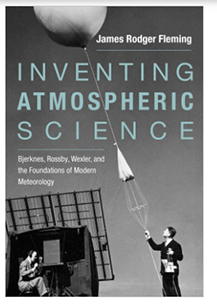 The first is a wonderful book called Inventing Atmospheric Science: Bjerknes, Rossby, Wexler and the Invention of Modern Meteorology by James Rodger Fleming. This is an excellent introduction to some of the early giants of modern meteorology and the creation of the national weather service (available on Kindle).
The first is a wonderful book called Inventing Atmospheric Science: Bjerknes, Rossby, Wexler and the Invention of Modern Meteorology by James Rodger Fleming. This is an excellent introduction to some of the early giants of modern meteorology and the creation of the national weather service (available on Kindle).
My next suggestion is The Weather Machine by Andrew Blum. This is really a modern history of numerical weather forecasting and the creation of the present models we use today. The explanations are easy to understand. One of the more fascinating explanations is that the foundation of the present numerical models is based on three partial differential equations developed by Wilhelm Bjerknes and the Bergen School of Meteorology in Norway. Fascinating!
General Overview of Weather
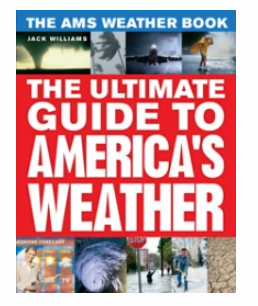 The next ‘slew’ of books deals with the overview type. These books will give you an idea of the broad concepts of the atmosphere so you can understand how they affect your observations locally: “Think global to act local,”
The next ‘slew’ of books deals with the overview type. These books will give you an idea of the broad concepts of the atmosphere so you can understand how they affect your observations locally: “Think global to act local,”
The first is close to home: The AMS Ultimate Guide to American Weather. This is self explanatory, giving the reader the very broad aspects of weather.
General Handbooks
There are two excellent “handbooks” that cover the global movements but quickly focus on local weather observations and predictions. The first is The National Audubon Society Field Guide to North American Weather. This is an excellent guide, especially for national/local weather systems and many color plates for specific cloud observations. 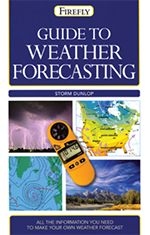 One small handbook I have found quite useful is the Firefly Guide to Weather Forecasting by ‘Storm’ Dunlop (figure that first name!). I assume this is a British author, so you get a different perspective. There is an excellent two-page graphic explanation of numerical weather forecasting that makes sense for the ‘mathematically challenged’ But, if you just need one small book this one is excellent.
One small handbook I have found quite useful is the Firefly Guide to Weather Forecasting by ‘Storm’ Dunlop (figure that first name!). I assume this is a British author, so you get a different perspective. There is an excellent two-page graphic explanation of numerical weather forecasting that makes sense for the ‘mathematically challenged’ But, if you just need one small book this one is excellent.
Satellite Image Interpretation
The next book is special: An Introduction to Satellite Image Interpretation by Eric D. Conway and The Maryland Space Grant Consortium. The title is a bit misleading, but this particular book is a real find. Here’s why. The ability to ‘read’ satellite visuals in different modems give us a way to see the weather literally as it unfolds. Remember that the atmosphere is really like a constantly flowing, undulating combination of gases at different levels. 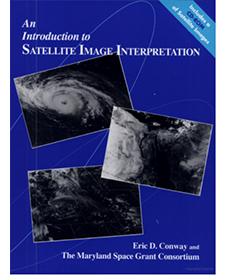 Seeing "real-time," different slices of the atmosphere in various modes such as infrared or water vapor and the entire array of cloud formations gives one insight and observations that really help to understand atmospheric movements and how they will affect your location. Here’s a neat way to use this book interactively: go to the Penn State GOES Satellite website. Observe how the different real-time images change as the flow of the atmosphere moves forward.
Seeing "real-time," different slices of the atmosphere in various modes such as infrared or water vapor and the entire array of cloud formations gives one insight and observations that really help to understand atmospheric movements and how they will affect your location. Here’s a neat way to use this book interactively: go to the Penn State GOES Satellite website. Observe how the different real-time images change as the flow of the atmosphere moves forward.
The really cool contribution of this book is that it provides basic, graduated explanations of the atmospheric circulation (i.e., Rossby Waves, Hadley Cells, Jet Stream, etc.) in the first part of the book; including how the circulation relates to the satellite visuals and national/local weather. If I were teaching a basic course in broad weather movements with visual explanations to middle and high school children, I would use this book. I always find something new when I look through it, and I’ve had the book for ten years.
Tim Vasquez and Weather Graphics
I’m doing something quite unusual here. I’m dedicating this section to one person because he has made a career of creating software programs and writing amazing books specifically dedicated to the serious weather amateur. When I say serious, I mean it. Tim was a meteorologist for the Navy and has been a contributor to Weatherwise Magazine in preparing weather maps for the amateur to create one’s own forecast or place observations with the data he provides, usually of a weather situation from a particular day in the past. That is a very modest explanation of Tim’s capabilities. Tim’s company Weather Graphics is completely dedicated to very serious amateurs, having created a computer program called Digital Atmosphere. This is a computer-generated blank base map that allows the user to populate the map with real time data made available in the program from various sources to create one’s own forecast. There are more ‘bells and whistles’ than I could even guess at, but it's an amazing piece of work and it's not expensive. If you review his website, you will see all kinds of weather programs. He also holds YouTube tutorials intermittently called Weather Lab. He is a master at teaching the amateur. I am constantly in awe of how he can predict the movement of systems from the various website data sets (usually Pivotal Weather among others - see my blog post from a couple of months ago).
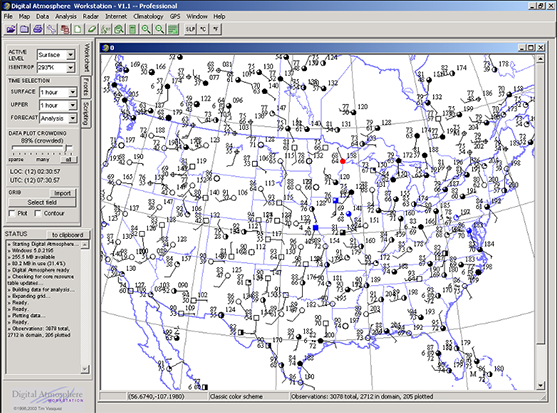
Tim’s “Handbooks”
Tim has also written a number of excellent texts for the amateur. These are not overly technical, but they are not for the general public, in my opinion. I’ll just name a few without getting too much into detailed explanations. If you are a serious amateur, then I recommend the following handbooks in graduated order:
- Weather Map Handbook: This book was last updated in 2015. It provides an excellent explanation of every kind of map at each level of the atmosphere including numerical ones. I started with this one because maps can provide excellent visual explanations in meteorology, and I was dealing with the maps daily. This also includes reading radar.
- Weather Analysis & Forecasting Handbook: Another one of those “if you had just one book” types. Simple explanations including initial planetary circulation. Tim uses simple sketches to explain complex processes.
- Weather Forecasting Red Book: There is quite a bit of duplication with the forecasting handbook, but the cool thing about this book is that it’s a true handbook. If you need a quick answer, this is the book,
- Severe Storm Forecasting Handbook: I love this book because it really gets into detailed but simple explanations of severe storms - supercell and complex thunderstorms and tornado formation and movement. He includes quite a bit about severe storm radar interpretation, plus how to read the skew-t charts and hodographs as predictive tools for the atmospheric instability necessary for severe storms.
- Instability, Skew-T & Hodograph Handbook: I saved the best for last. Here’s why. If you can understand skew-t and hodograph, you can call yourself a serious enthusiast. (Alert. I’m not there yet!). This book could really be higher on my list, but it can be a bit technical because of the nature of the information. The beauty of the skew-t and hodograph is that they are fairly simple concepts, literally giving one a three-dimensional ‘view’ of the atmosphere. It takes quite a bit of practice to understand these two tools, but they are fundamental. More to come on these in the forecasting piece coming in my next blog post.
Tim has a few new handbooks which I will probably order soon. I would suggest looking over his website and see what interests you. I have no commercial or any other kind of interest in Weather Graphics. In fact, Tim doesn’t know I’m writing this blog, nor do I think he would know me personally. I did send him a note some years ago that he needed a better marketing plan; that he was the best kept secret in the amateur weather ‘business.’
Take a look at some of these ideas and see what piques your interest.
Remember it’s the book you don’t read that will hurt you.
